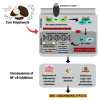Anticancer and Immunomodulatory Benefits of Taro (Colocasia esculenta) Corms, an Underexploited Tuber Crop
- PMID: 33383887
- PMCID: PMC7795958
- DOI: 10.3390/ijms22010265
Anticancer and Immunomodulatory Benefits of Taro (Colocasia esculenta) Corms, an Underexploited Tuber Crop
Abstract
Taro corms contain valuable bioactive molecules effective against cancer and cancer-related risk factors, such as carcinogens and biological agents, several pathophysiological conditions, including oxidative stress and inflammation, while controlling metabolic dysfunctions and boosting the immunological response. Such broad effects are achieved by the taro health-influencing compounds displaying antitumoral, antimutagenic, immunomodulatory, anti-inflammatory, antioxidant, anti-hyperglycemic, and anti-hyperlipidemic activities. Taro bioactivities are attributed to the combination of tarin, taro-4-I polysaccharide, taro polysaccharides 1 and 2 (TPS-1 and TPS-2), A-1/B-2 α-amylase inhibitors, monogalactosyldiacylglycerols (MGDGs), digalactosyldiacylglycerols (DGDGs), polyphenols, and nonphenolic antioxidants. Most of these compounds have been purified and successfully challenged in vitro and in vivo, proving their involvement in the aforementioned activities. Although these health-promoting effects have been recognized since ancient times, as well as other valuable features of taro for food profit, such as hypo-allergenicity, gluten-free, and carbohydrates with medium-glycemic index, taro crop remains underexploited. The popularization of taro intake should be considered a dietary intervention strategy to be applied to improve the overall health status of the organism and as supportive therapy to manage tumorigenesis.
Keywords: COX-2 down-regulation; health-promoting compounds; metabolism modulation; resistant starch; taro dietary intervention.
Conflict of interest statement
The authors declare no conflict of interest.
Figures




Similar articles
-
In vitro starch digestibility, estimated glycemic index and antioxidant potential of taro (Colocasia esculenta L. Schott) corm.Food Chem. 2015 Feb 1;168:257-61. doi: 10.1016/j.foodchem.2014.07.052. Epub 2014 Jul 14. Food Chem. 2015. PMID: 25172708
-
Nutritional, phytochemical composition and potential health benefits of taro (Colocasia esculenta L.) leaves: A review.Food Chem. 2022 Jul 30;383:132406. doi: 10.1016/j.foodchem.2022.132406. Epub 2022 Feb 14. Food Chem. 2022. PMID: 35176712 Review.
-
Taro starch: Isolation, morphology, modification and novel applications concern - A review.Int J Biol Macromol. 2020 Nov 15;163:1283-1290. doi: 10.1016/j.ijbiomac.2020.07.093. Epub 2020 Jul 14. Int J Biol Macromol. 2020. PMID: 32673724 Review.
-
Production of resistant starch from taro (Colocasia esculenta L. Schott) corm and determination of its effects on health by in vitro methods.Carbohydr Polym. 2012 Oct 15;90(3):1204-9. doi: 10.1016/j.carbpol.2012.06.039. Epub 2012 Jun 21. Carbohydr Polym. 2012. PMID: 22939332
-
Liposomal Taro Lectin Nanocapsules Control Human Glioblastoma and Mammary Adenocarcinoma Cell Proliferation.Molecules. 2019 Jan 29;24(3):471. doi: 10.3390/molecules24030471. Molecules. 2019. PMID: 30699910 Free PMC article.
Cited by
-
Evaluation of Plant-Based Silver Nanoparticles for Antioxidant Activity and Promising Wound-Healing Applications.ACS Omega. 2024 Mar 1;9(10):12146-12157. doi: 10.1021/acsomega.3c10489. eCollection 2024 Mar 12. ACS Omega. 2024. PMID: 38496949 Free PMC article.
-
Taro Lectin Can Act as a Cytokine-Mimetic Compound, Stimulating Myeloid and T Lymphocyte Lineages and Protecting Progenitors in Murine Bone Marrow.Pharmaceutics. 2021 Mar 7;13(3):350. doi: 10.3390/pharmaceutics13030350. Pharmaceutics. 2021. PMID: 33800086 Free PMC article.
-
Physiological, anatomical and quality indexes of root tuber formation and development in chayote (Sechium edule).BMC Plant Biol. 2023 Sep 7;23(1):413. doi: 10.1186/s12870-023-04427-0. BMC Plant Biol. 2023. PMID: 37674150 Free PMC article.
-
A Concise Review on Taro Mucilage: Extraction Techniques, Chemical Composition, Characterization, Applications, and Health Attributes.Polymers (Basel). 2022 Mar 15;14(6):1163. doi: 10.3390/polym14061163. Polymers (Basel). 2022. PMID: 35335495 Free PMC article. Review.
-
Tarin-Loaded Nanoliposomes Activate Apoptosis and Autophagy and Inhibit the Migration of Human Mammary Adenocarcinoma Cells.Int J Nanomedicine. 2023 Nov 7;18:6393-6408. doi: 10.2147/IJN.S434626. eCollection 2023. Int J Nanomedicine. 2023. PMID: 37954458 Free PMC article.
References
-
- Abele S., Frohberg K. Subsistence Agriculture in Central and Eastern Europe: How to Break the Vicious Circle? Oxford University Press; New York, NY, USA: 2004.
-
- Temesgen M., Retta N. Nutritional potential, health and food security benefits of taro Colocasia esculenta (L.): A Review. Food Sci. Qual. Manag. 2015;36:23–30.
-
- Siqueira M.V. Yam: A neglected and underutilized crop in Brazil. Hortic. Bras. 2011;29:16–20. doi: 10.1590/S0102-05362011000100003. - DOI
-
- Akwee P., Netondo G., Palapala V.A. A critical review of the role of taro Colocasia esculenta L.(Schott) to food security: A comparative analysis of Kenya and Pacific Island taro germplasm. Sci. Agric. 2015;9:101–108. doi: 10.15192/PSCP.SA.2015.9.2.101108. - DOI
Publication types
MeSH terms
Substances
Grants and funding
- E-26/203.039/2015, E-26/202.815/2018, E-26/210.865/2019, E-26/202.459/2019. and E-26/200.567/2020/Fundação Carlos Chagas Filho de Amparo à Pesquisa do Estado do Rio de Janeiro
- 406601/2018-6/Conselho Nacional de Desenvolvimento Científico e Tecnológico
- 88882.461696/2019-01/Coordenação de Aperfeiçoamento de Pessoal de Nível Superior
LinkOut - more resources
Full Text Sources
Research Materials

